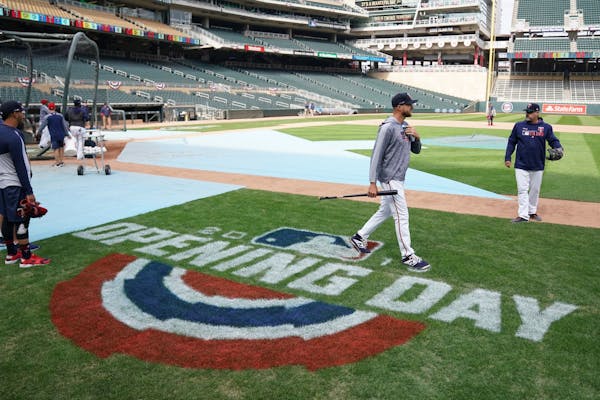The official record book for the Minnesota Twins traces the roots of the franchise to the start of the American League in 1901, with the Washington Senators. One notable player on that club was catcher Boileryard Clarke, a veteran of eight seasons in the established National League and said to be particularly sharp with his pitch framing.
There was also a starting pitcher named Win Mercer, and he had a 9-13 record for a Senators club that finished 61-72 and sixth in the new eight-team league.
The Senators came under control of Clark Griffith, an outstanding pitcher as a baseball pioneer from 1891 to 1914, in 1920. It was eight years later that Charles Dryden wrote of the Washington ballclub in the Saturday Evening Post:
"First in war, first in peace, and last in the American League."
Odd that was written in 1928, between the Senators' three World Series appearances — 1924 (W), 1925 (L) and 1933 (L) — and not during the long decades that followed, when Washington's only pennant came in a 1954 novel written by Douglass Wallop and then turned into the popular play "Damn Yankees."
No matter.
Dryden's great line stood for 90 years as the most ridicule-filled slogan in Washington/Minnesota franchise history, until the Twins slapped one on themselves, "This Is How We Baseball," in 2018.
The Twins were so upset by the barbs taken over this that they not only fired the advertising agency, they also fired manager Paul Molitor and most of his staff for failing to win more than 78 games with a team subpar in talent only in the areas of hitting, pitching, fielding and baserunning.
The Twins will open the franchise's 59th season in Minnesota with a home game on Thursday against the Cleveland Indians. The three-time defending AL Central champions arrive here facing the losses of Francisco Lindor to injury, Michael Brantley, Andrew Miller and Cody Allen to free agency and Chief Wahoo to it's-about-time.
This will occur only 24 days earlier on the calendar than did the Twins' first-ever home game, on April 21, 1961, against their Washington stepchildren, the expansion Senators.
The Twins had gone 5-1 on a road trip — 1-0 vs. the Yankees and Red Sox, 3-1 vs. Baltimore — and were in first place in the 10-team American League. There were 24,606 in attendance, nearly 6,000 under the capacity of a ballpark that still was being completed.
Maybe it was those prices: After all, it was $3.50 for a box seat, $1.50 to sit in the bleachers, and, what, $1.50 for a beer in a cup? Plus, gas and a couple of bucks for parking.
We Scandinavians and Germans loved that major league baseball had come to the Bloomington prairie, with that guy Harmon to hit majestic home runs and a pitcher named Camilo to accumulate whiffs with a magnificent curveball, but we loved our paper money even more.
(Attention, copy editors: We don't need the usual "announced crowd of'' for the reference to 24,606, since in those earlier decades the attendance figure came from the turnstile count and wasn't based on tickets sold, distributed or imagined.)
The Twins lost that first one, 5-3, to the makeshift roster of the new Senators and, for what wouldn't be the last time, owner Calvin Griffith lamented that the fans hadn't filled the ballpark.
Now, all these years later, the Twins have been huffing-and-puffing (that's a puffer-jacket giveaway joke) to keep their Opening Day sellout streak alive at Target Field.
The tradition through the years for the sporting press has been to reach deep into the vault of corny prose to salute the arrival of Opening Day, when hope is alleged to spring eternal, and our grandest game — the only one without a clock — is played out at its own pace in a pastoral setting that takes us back to the wonder of our first game with a parent or grandparent.
I was with my father, sitting in good seats for that first Twins game at the Met, and Dick Reusse's passion for baseball was passed on to me, but the game we mutually cherished was contested with the ball regularly in play, not with every at-bat a four-minute struggle that has been set up through the analysis of a dozen graduates of Ivy League-level learning.
The game the Reusse boys admired was an art, not a science.
The highlight of this past spring training for me was this:
The story I heard that the Detroit Tigers had one of their expensive cameras unattended on a stand behind the fence at a field, placed there to break down the minuscule movements of the athletes in a forthcoming workout, and two civilians drove up behind the fence, loaded the camera in a truck and drove off.
I see them not as criminals but as defenders of the Grand Old Game.
Then again, the 2019 baseball season is not without hope. The Twins have elected to go without a slogan.
Reusse: Shaver was 'Voice of the North Stars' and an all-time great guy

Reusse: There's no doubt Finch is the right coach for the Wolves

Reusse: How bad are the White Sox? They made Twins look good.

Reusse's Tortured Columnist Department update: Yes, Vikings won the offseason


